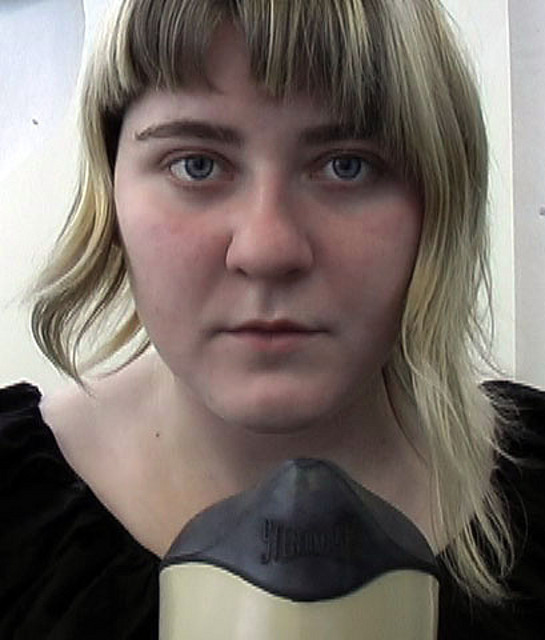Project Description:
In the Lecture-Machine performance, I take on the persona of a lecturer, and deliver a talk on the relationship between speech and text; the quest for an insertion of humanity, in the form of the voice, into our relationship with technology; and the endless tasks of learning and interpretation that surround the spoken word. I lecture into a Stenomask, a voice-silencing device which was once commonly used in courts of law by court reporters. The Stenomask is connected to a computer with voice recognition capabilities. During the performance, the computer’s interpretation of my lecture is displayed live, as it is translated from speech to text, in Powerpoint slides or as captions overlaid on video. This textual output reveals the many flaws in the computer’s analysis. Simultaneously, a digitized voice reads the original text of the lecture aloud. The computer/software, the Stenomask, and my voice work as a trinity to form lectures where the meaning is layered and emerges as the computer interprets my speech.
The computer and I are engaged in an intense form of mutual training, where I attempt to conform my speech to its expectations, and the computer applies its logic to my utterances. The audience observes each instance of slippage in meaning between the original lecture that is heard and the interpreted lecture that is presented as text. My performance depicts the endless tasks of learning and interpretation that surround the spoken word, and how devotion to repetitive tasks as part of structured activity (legal proceedings, animal training, personalization of technology) is analogous to the patterns we form in developing relationships with others. The piece draws from a rich base of cultural references – William Butler Yeats, Albert Camus, Franz Kafka, Pablo Neruda, the Bible, and others. A soundtrack was produced by pianist Daniel Cockburn, especially for the Montreal performance of this piece.
From an essay by Lois Brown:
“…Lecture-Machine was very much alive, joyful, even. Lecture-Machine was wry in tone, rhythmic – the dynamic between speech and text and sound almost mesmerizing – certainly entrancing.
Lecture-Machine explores a public and private voice tension – Michelle’s training of her device is quite private and her text and presentation public.
Meaning is quite private – she attends to where the machine misunderstands her. Using artefacts of lecture culture, she builds what she calls a “holy trinity” of voice/myself, the Stenomask, and Via Voice software: an impenetrable holy trinity. I heard the computer–voice, the text, and the natural voice all overlapping to create a lulling rhythm – the dynamic in the meanings, mistakes and misinterpretations creating playful “hermeneutic clashes” between the words and contexts.”
Past Presentations: Edge Intermedia, St. John’s, Nfld. October 2004.
Palais de Justice de Montreal, January 2006.
Project supported by a CIAM project grant for graduate students.
